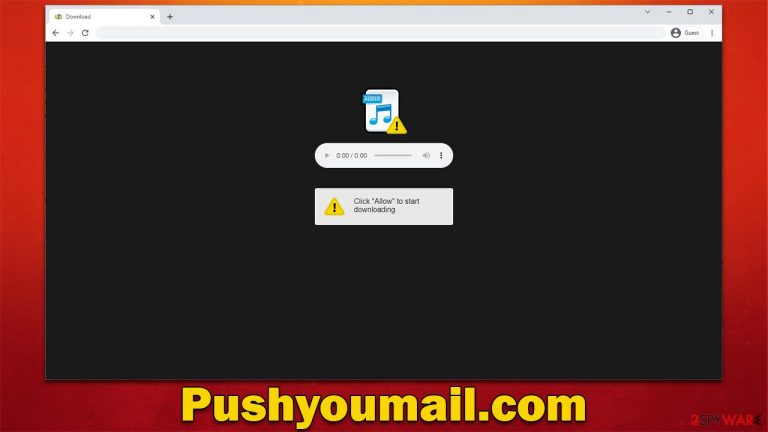Pushyoumail.com ads (fake) - Free Instructions
Pushyoumail.com ads Removal Guide
What is Pushyoumail.com ads?
Pushyoumail.com is a scam website designed by crooks to make people subscribe to push notifications

If you frequently see Pushyoumail.com pop-ups on your computer, you've probably been tricked by a deceptive message while browsing the web. After users click a malicious link elsewhere or when their computers are infected with adware[1] or other harmful malware, redirection to fraudulent websites is common.
If you are unexpectedly redirected to a fake statement, such as one that encourages you to confirm your age or that you are not a robot, do not click the “Allow” button. This would immediately allow the website to deliver push notifications without limitations directly to desktops, as long as the browser runs.
Not only are Pushyoumail.com ads annoying, but they might also be dangerous. Malicious ads are a common way for cybercriminals to spread their harmful programs, such as viruses and Trojans. If you click on the wrong ad, you could end up infecting your system with all kinds of malware. Redirects may also ask you to subscribe to useless services that cost money or make you provide sensitive details such as phone or credit card information, which could be misused later.
What are push notifications, and how can they be misused?
Users are frequently unfamiliar with push notifications, even though they may be enabled on numerous sites. The option was initially implemented in the Google Chrome browser in 2015 and has since been widely adopted. As a result, it's not unusual to see a push notification request appear when you visit almost any entertainment or news site.
Although this feature can be useful for users and website authors – where the former receives notifications about things they are interested in, and the latter gains more traffic to their site – the reality is quite different. This is because most people do not want to be bothered by annoying pop-ups on their screens without warning.
It is one's preference whether or not they want to enable push notifications from particular websites, as it can be beneficial. However, scammers use the feature for their malicious deeds, and in this case, they insert ads, misleading statements, and links into push notifications. Once exposed, users could end up on malicious websites, infecting their systems with various malware, losing money to useless services, or revealing their personal details to cybercriminals.
| Name | Pushyoumail.com |
| Type | Push notifications, ads, pop-ups, scam |
| Distribution | You can start seeing intrusive pop-ups at some point after you click the “Allow” button within the site's notification prompt |
| Symptoms | Pop-ups show up on a regular basis on the screen – these ads often include inappropriate, scam, phishing, or other similar content |
| Risks | Push notifications can contain ads that might be misleading and direct you to malicious websites. If you click on them, you could end up infecting your system with malware or revealing personal information to cybercriminals |
| Removal | To stop push notifications that won't leave you alone, access your browser settings. Furthermore, ensure that your system is not infected with adware or malware by scanning it with SpyHunter 5Combo Cleaner |
| Other tips | Do not forget to clean your browsers properly to avoid the return of ads and further data tracking. You can also repair damaged system files with FortectIntego |
Scam messages can be deceiving
Not many individuals would want to sign up for notifications that might quickly provide deceptive information to their computer screens. Scammers who use push notification scams are aware of this, therefore they devise methods to get people to perform activities they wouldn't otherwise do. To accomplish this, they utilize social engineering[2] tactics.
Redirects to websites like Pushyoumail.com happen abruptly and unexpectedly, which is a part of the crooks' scam scheme. When users are presented with something unexpected, they are less likely to think it through. When looking a the messages that are presented in front of them, it is not difficult to see how they might be misled:
- Please tap Allow to continue
- Click “Allow” to win a prize and get it in our shop!
- Press “Allow” to verify, that you are not a robot
- If you are 18+, click Allow
- Click “Allow” to start downloading, etc.

Users have all previously encountered an age verification check and had to go through captchas and similar verification methods used by websites to prevent DDoS[3] attacks against them. These facts are what scammers are trying to abuse, and they are replicated in numerous websites of similar nature, including Ponuadema.com, Ourhugenews.com, Whackyblue.com, and many others.
Removal of Pushyoumail.com ads
Users frequently ask whether push notifications are the result of a computer virus. It's worth noting that this isn't the case. Instead, these alerts come from the web browser and can appear only if users allow it.
However, many deceitful websites send notifications with content the user has not consented to. In order to stop this behavior, you need to go into your browser settings and deny access to Pushyoumail.com (or similar sites). See below for instructions on how to do that.
Google Chrome
- Open the Google Chrome browser and go to Menu > Settings.
- Scroll down and click on Advanced.
- Locate the Privacy and security section and pick Site Settings > Notifications.
- Look at the Allow section and look for a suspicious URL.
- Click the three vertical dots next to it and pick Block. This should remove unwanted notifications from Google Chrome.

Google Chrome (Android)
- Open Google Chrome and tap on Settings (three vertical dots).
- Select Notifications.
- Scroll down to the Sites section.
- Locate the unwanted URL and toggle the button to the left (Off position).

Mozilla Firefox
- Open Mozilla Firefox and go to Menu > Options.
- Click on Privacy & Security section.
- Under Permissions, you should be able to see Notifications. Click the Settings button next to it.
- In the Settings – Notification Permissions window, click on the drop-down menu by the URL in question.
- Select Block and then click on Save Changes. This should remove unwanted notifications from Mozilla Firefox.

Safari
- Click on Safari > Preferences…
- Go to the Websites tab and, under General, select Notifications.
- Select the web address in question, click the drop-down menu and select Deny.

MS Edge (Chromium)
- Open Microsoft Edge, and go to Settings.
- Select Site permissions.
- Go to Notifications on the right.
- Under Allow, you will find the unwanted entry.
- Click on More actions and select Block.

Internet Explorer
- Open Internet Explorer, and click on the Gear icon at the top-right of the window.
- Select Internet options and go to the Privacy tab.
- In the Pop-up Blocker section, click on Settings.

- Locate the web address in question under Allowed sites and pick Remove.
While the intrusive activity from the site via the push notification feature is not a result of a virus infection, it is still particularly important to check your system with SpyHunter 5Combo Cleaner, Malwarebytes, or another reputable anti-malware. Redirects to suspicious phishing websites may also occur due to adware or some other computer infections, so it is vital to check it thoroughly.
Once you are sure that malware is eliminated from your device, we also advise using the FortectIntego PC repair and maintenance tool that could easily remove PUP leftover files used for tracking and other activities. The app can also easily fix virus damage, preventing users from having to reinstall their systems in case of failures.
How to prevent from getting adware
Stream videos without limitations, no matter where you are
There are multiple parties that could find out almost anything about you by checking your online activity. While this is highly unlikely, advertisers and tech companies are constantly tracking you online. The first step to privacy should be a secure browser that focuses on tracker reduction to a minimum.
Even if you employ a secure browser, you will not be able to access websites that are restricted due to local government laws or other reasons. In other words, you may not be able to stream Disney+ or US-based Netflix in some countries. To bypass these restrictions, you can employ a powerful Private Internet Access VPN, which provides dedicated servers for torrenting and streaming, not slowing you down in the process.
Data backups are important – recover your lost files
Ransomware is one of the biggest threats to personal data. Once it is executed on a machine, it launches a sophisticated encryption algorithm that locks all your files, although it does not destroy them. The most common misconception is that anti-malware software can return files to their previous states. This is not true, however, and data remains locked after the malicious payload is deleted.
While regular data backups are the only secure method to recover your files after a ransomware attack, tools such as Data Recovery Pro can also be effective and restore at least some of your lost data.
- ^ Adware. Investopedia. Source of financial content on the web.
- ^ Social Engineering. Imperva. Application and data security.
- ^ What is a DDoS attack?. Cloudflare. The Web Performance & Security Company.
